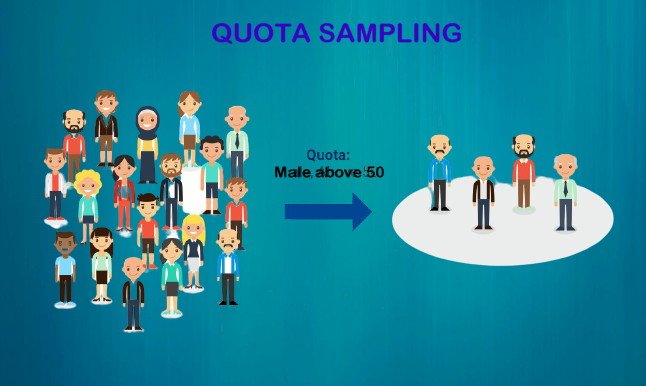Quota sampling is a non-probability sampling technique where in the assembled sample has the same proportions of individuals as the entire population with respect to known characteristics, traits, or focused phenomenon. This sampling procedure is completely opposite to probability sampling. Researchers then select participants from each quota to ensure representation. Unlike random sampling, quota sampling allows researchers to focus on specific traits, making it highly efficient for market research, social studies, and opinion polls.
Key Features of Quota Sampling
- Predefined Quotas – Researchers categorize the population based on attributes like age, gender, income, or education.
- Non-Random Selection – Unlike probability sampling, researchers handpick participants to match the required quotas.
- Time and Cost Efficiency – This method speeds up data collection without requiring a complete population survey.
- Enhanced Representation – Ensures that underrepresented groups are included, improving the diversity of responses.
Types of Quota Sampling
- Proportional Quota Sampling – The sample distribution matches the proportion of the subgroups in the population. For example, if 60% of a population is female, then 60% of the sample should also be female.
- Non-Proportional Quota Sampling – Researchers ensure a minimum number of participants from each subgroup, even if the distribution does not reflect the actual population.
When to use Quota Samples
The main reason why researchers choose quota samples is that it allows the researchers to sample a subgroup that is of great interest to the study. If a study aims to investigate a trait or a characteristic of a certain subgroup, this type of sampling is the ideal technique.
Quota sampling also allows the researchers to observe relationships between subgroups. In some studies, traits of a certain subgroup interact with other traits of another subgroup. In such cases, it is also necessary for the researcher to use this type of sampling technique.
How to Conduct Quota Sampling
Quota Sampling is a technical job and requires some steps to be handled carefully. The steps are below:
1: Define the Population & Set Quotas: In this step, we analyze our data and choose the traits or characteristics to be chosen for the classification of the data. Traits can be:
- Country of Origin
- Caste
- Height
- Level of Education
- Sex
- Age Group
- Level of Employment
2: Select Participants or Samples: In this step, we calculate the number of samples that are to be taken from each of the groups. This is done proportionally with the formula:
Number of Samples taken from a group = Number of Items in the Group (Total number of Samples to be taken /Total number of Items in the population)
3: Analyze Data – Interpret findings while considering potential biases.
Advantages of Quota Sampling
- Faster Data Collection – Researchers do not need a complete sampling frame.
- Cost-Effective – Saves resources by targeting specific groups.
- Flexible – Allows researchers to refine participant selection based on evolving study needs.
- Useful for Hard-to-Reach Populations – Ensures representation from groups that might be overlooked in random sampling.
More Precisely,
- Relatively easy to administer.
- Can be performed quickly.
- Cost-effective.
- Accounts for population proportions.
- A useful method when probability sampling techniques are not possible.
Disadvantages of Quota Sampling
- Potential Bias – Since researchers handpick participants, selection bias may influence results.
- Limited Generalizability – Findings may not be representative of the entire population.
- Subjectivity in Selection – Researchers’ choices can impact the reliability of results.
More Precisely,
- Sample selection is not random.
- There is a potential for selection bias, which can result in a sample that is unrepresentative of the population.
- Other issues related to items that can not be categorized into certain groups.
Applications of Quota Sampling
- Market Research – Businesses use it to understand customer preferences and trends.
- Political Polling – Ensures representation of diverse voter demographics.
- Healthcare Studies – Helps in studying specific patient groups.
- Social Research – Examines behaviors and opinions within distinct communities.
Connection to Stratified sampling
Quota sampling is the non-probability version of stratified sampling. In stratified sampling, researchers create subsets of the population based on a common characteristic, such as gender. They then randomly select subjects from each subset, ensuring that every potential subject has a known probability of being chosen—unlike in quota sampling. However, this process may inadvertently overrepresent other traits within the sample. In a study that considers gender, socioeconomic status, and religion based on the subgroups, the final sample may have a skewed representation of age, race, educational attainment, marital status, and a lot more.
Conclusion
Quota sampling is a valuable tool for researchers who need structured yet flexible data collection. While it has limitations, its efficiency and targeted approach make it a preferred method in various fields. By understanding its advantages and challenges, researchers can effectively use quota sampling to gain meaningful insights.

